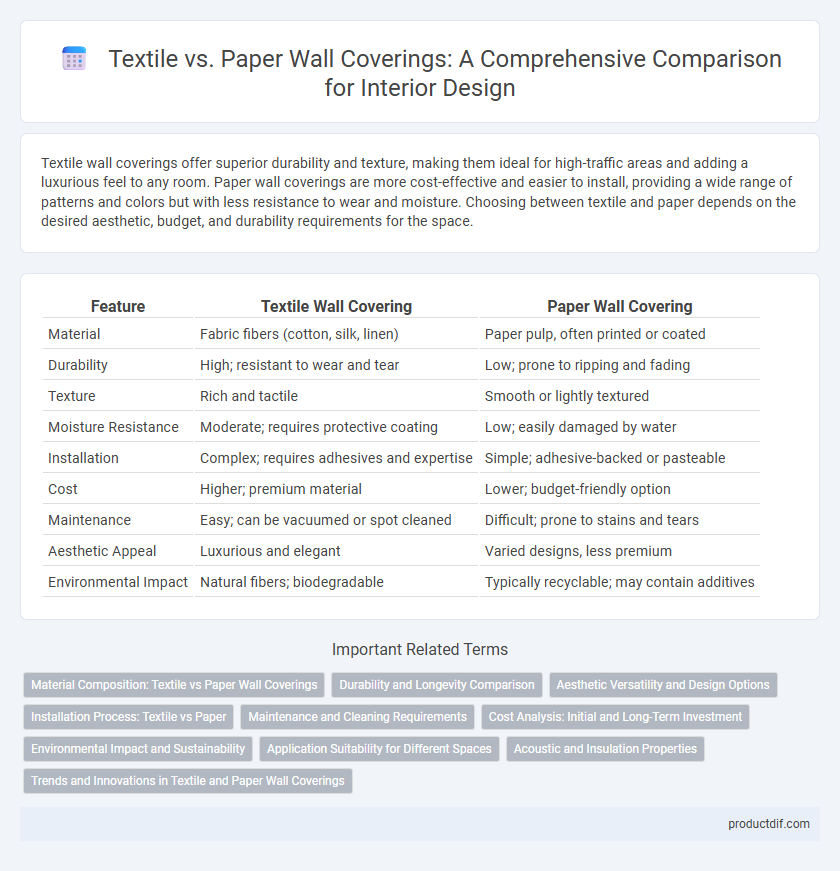Textile wall coverings offer superior durability and texture, making them ideal for high-traffic areas and adding a luxurious feel to any room. Paper wall coverings are more cost-effective and easier to install, providing a wide range of patterns and colors but with less resistance to wear and moisture. Choosing between textile and paper depends on the desired aesthetic, budget, and durability requirements for the space.
Table of Comparison
| Feature | Textile Wall Covering | Paper Wall Covering |
|---|---|---|
| Material | Fabric fibers (cotton, silk, linen) | Paper pulp, often printed or coated |
| Durability | High; resistant to wear and tear | Low; prone to ripping and fading |
| Texture | Rich and tactile | Smooth or lightly textured |
| Moisture Resistance | Moderate; requires protective coating | Low; easily damaged by water |
| Installation | Complex; requires adhesives and expertise | Simple; adhesive-backed or pasteable |
| Cost | Higher; premium material | Lower; budget-friendly option |
| Maintenance | Easy; can be vacuumed or spot cleaned | Difficult; prone to stains and tears |
| Aesthetic Appeal | Luxurious and elegant | Varied designs, less premium |
| Environmental Impact | Natural fibers; biodegradable | Typically recyclable; may contain additives |
Material Composition: Textile vs Paper Wall Coverings
Textile wall coverings are composed of natural fibers such as cotton, linen, and silk, often blended with synthetic materials to enhance durability and texture. Paper wall coverings are primarily made from cellulose fibers derived from wood pulp, offering a lightweight and cost-effective solution but with lower resistance to moisture and wear. The choice between textile and paper materials impacts durability, texture, maintenance, and aesthetic appeal in interior design applications.
Durability and Longevity Comparison
Textile wall coverings boast superior durability compared to paper alternatives, with woven fabrics such as silk, linen, and cotton resisting wear, moisture, and fading over time. Paper wall coverings, while cost-effective and easy to replace, tend to be more susceptible to tearing, staining, and humidity damage, resulting in a shorter lifespan. Investing in textile wall coverings ensures prolonged aesthetic appeal and structural integrity, making them ideal for high-traffic or humid environments.
Aesthetic Versatility and Design Options
Textile wall coverings offer rich textures and depth, enhancing aesthetic versatility with patterns that range from intricate weaves to bold prints, suitable for both classic and contemporary interiors. Paper wall coverings provide a vast array of design options, including vibrant colors, detailed illustrations, and customizable prints, allowing for easy adaptation to various decor styles. The choice between textile and paper depends on the desired tactile experience and visual impact within the space.
Installation Process: Textile vs Paper
Textile wall coverings require specialized adhesives and skilled installation techniques to ensure durability and prevent fabric stretching or sagging. Paper wall coverings are typically easier to install with standard paste and a smoother surface, but they are more prone to tearing and damage during application. Proper surface preparation and precise alignment are crucial for both materials to achieve a seamless finish.
Maintenance and Cleaning Requirements
Textile wall coverings demand delicate maintenance due to their fabric composition, requiring gentle vacuuming or spot cleaning with mild detergents to prevent damage or discoloration. Paper wall coverings are generally less durable when exposed to moisture, making it essential to avoid water-based cleaning methods and instead rely on dry dusting or light brushing. Regular upkeep of textile options extends their lifespan but involves higher care effort compared to the more straightforward, albeit less resilient, maintenance of paper coverings.
Cost Analysis: Initial and Long-Term Investment
Textile wall coverings typically involve a higher initial investment due to the cost of materials and installation complexity, often ranging from $10 to $30 per square foot compared to $1 to $5 for paper alternatives. Over the long term, textiles offer greater durability and stain resistance, reducing replacement and maintenance expenses, which can lead to cost savings despite the upfront premium. Paper wall coverings, while more affordable initially, tend to have shorter lifespans and higher susceptibility to damage, resulting in more frequent replacements and added cumulative costs over time.
Environmental Impact and Sustainability
Textile wall coverings often have a higher environmental footprint due to energy-intensive production and synthetic fiber use, which contribute to pollution and slower biodegradability. In contrast, paper wall coverings typically feature renewable materials and lower energy consumption during manufacturing, resulting in better recyclability and reduced waste. Choosing sustainably sourced or recycled textiles and eco-friendly paper options can significantly minimize the environmental impact of wall coverings.
Application Suitability for Different Spaces
Textile wall coverings offer superior durability and moisture resistance, making them ideal for high-traffic areas and humid environments such as kitchens and bathrooms. Paper wall coverings provide a cost-effective option suited for low-traffic, dry spaces like bedrooms and living rooms, where frequent cleaning is less critical. Choosing between textile and paper depends on the specific functional requirements and aesthetic preferences of each room.
Acoustic and Insulation Properties
Textile wall coverings offer superior acoustic absorption and thermal insulation compared to traditional paper options due to their dense fibers and layered construction. The porous nature of textiles reduces sound reverberation and enhances room acoustics, making them ideal for noise-sensitive environments. In contrast, paper wall coverings provide minimal sound dampening and lower insulation performance, limiting their effectiveness in controlling temperature and acoustics.
Trends and Innovations in Textile and Paper Wall Coverings
Textile wall coverings are experiencing a surge in popularity due to advancements in sustainable fibers and digital printing technologies that enable vibrant, customizable designs with enhanced durability. Paper wall coverings are evolving with eco-friendly materials and innovative coatings that improve moisture resistance and lifespan while maintaining affordability. Both categories integrate smart technologies, such as antimicrobial treatments and easy-installation adhesives, reflecting a growing demand for functional and stylish interior solutions.
Textile vs Paper Infographic

 productdif.com
productdif.com